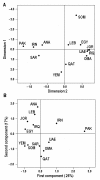Saudi Arabian Y-Chromosome diversity and its relationship with nearby regions
- PMID: 19772609
- PMCID: PMC2759955
- DOI: 10.1186/1471-2156-10-59
Saudi Arabian Y-Chromosome diversity and its relationship with nearby regions
Abstract
Background: Human origins and migration models proposing the Horn of Africa as a prehistoric exit route to Asia have stimulated molecular genetic studies in the region using uniparental loci. However, from a Y-chromosome perspective, Saudi Arabia, the largest country of the region, has not yet been surveyed. To address this gap, a sample of 157 Saudi males was analyzed at high resolution using 67 Y-chromosome binary markers. In addition, haplotypic diversity for its most prominent J1-M267 lineage was estimated using a set of 17 Y-specific STR loci.
Results: Saudi Arabia differentiates from other Arabian Peninsula countries by a higher presence of J2-M172 lineages. It is significantly different from Yemen mainly due to a comparative reduction of sub-Saharan Africa E1-M123 and Levantine J1-M267 male lineages. Around 14% of the Saudi Arabia Y-chromosome pool is typical of African biogeographic ancestry, 17% arrived to the area from the East across Iran, while the remainder 69% could be considered of direct or indirect Levantine ascription. Interestingly, basal E-M96* (n = 2) and J-M304* (n = 3) lineages have been detected, for the first time, in the Arabian Peninsula. Coalescence time for the most prominent J1-M267 haplogroup in Saudi Arabia (11.6 +/- 1.9 ky) is similar to that obtained previously for Yemen (11.3 +/- 2) but significantly older that those estimated for Qatar (7.3 +/- 1.8) and UAE (6.8 +/- 1.5).
Conclusion: The Y-chromosome genetic structure of the Arabian Peninsula seems to be mainly modulated by geography. The data confirm that this area has mainly been a recipient of gene flow from its African and Asian surrounding areas, probably mainly since the last Glacial maximum onwards. Although rare deep rooting lineages for Y-chromosome haplogroups E and J have been detected, the presence of more basal clades supportive of the southern exit route of modern humans to Eurasian, were not found.
Figures

References
-
- Tosi M. The emerging picture of Prehistoric Arabia. Ann Rev Anthrop. 1986;15:461–490. doi: 10.1146/annurev.an.15.100186.002333. - DOI
-
- Sauer C. Seashore, primitive home of man? Proc Am Phil Soc. 1962;106:41–47.
-
- Lahr M, Foley R. Multiple dispersals and modern human origins. Evol Anthropol. 1994;3:48–60. doi: 10.1002/evan.1360030206. - DOI
-
- Petraglia M. The lower Paleolithic of the Arabian Peninsula: Occupations, adaptations, and dispersals. J World Prehist. 2003;17:141–179. doi: 10.1023/A:1025849206519. - DOI
-
- Petraglia M, Alsharekh A. The Middle Palaeolithic of Arabia: Implications for modern human origins, behaviour and dispersals. Antiquity. 2003;77:671–684.
Publication types
MeSH terms
LinkOut - more resources
Full Text Sources
Miscellaneous

